The seals and seal impressions are the real jewels of the Babylonian Collections of the Museum. Up to the present day, they number about 804 stone seals of various forms, 3 stone or metal rings, and 226 seal impressions on clay. They have been acquired since 1888, by purchase, by excavation mainly at Nippur, and by gift. Their interest makes of them one of the important collections of the world.
Next to larger but rare historical monuments like stelae and statues, they build a fairly unbroken chain of minor evidences most precious for a study of the origin and development of Babylonian history, art, religion and epigraphy. Such archæological and historical information is a great help toward a better classification of the seals in time and space. Many, like Ward and Delaporte, who have written on the same subject, have kept under their eye that common aim. Dated seals, and impressions of seals on dated tablets, have been their first and valuable guide. The progress of research has supplied of late three new elements of information, which are, an early chronology going back to nearly B.C. 5000; an early Elamite art on painted vases and seals before B.C. 3000; and a better known Akkadian empire about B.C. 2700. The early chronology gives us a fairly complete succession of Sumerian kingdoms. The early Elamite art has established a new standard of naturalistic and geometrical design, that knew four main rules of composition. The same subject repeated several times formed a frieze. The same subject might be repeated, but reversed and opposed upside down to the preceding. Or an heraldic composition would place symmetrical figures on either side of a central one. Finally, in the absence of true perspective, face and profile would combine in a characteristic archaic way. The better known Akkadian empire and its growing importance have enhanced the value of the Akkadian art. That period from B.C. 2700 to B.C. 2500 is the golden age of Babylonian production. The ruin of the Akkadian Empire was caused by the invasion of the Guti, wild tribes from the eastern Highlands, about B.C. 2400. They are the first, historically known, of those tribal waves that swept at intervals over the old culture land. They were followed by the Cassites, about B.C. 1700, and the Persians, about B.C. 500, before the Arabs, the Mongols, and the Turks.
All those invasions have left their mark in art, and particularly in seal engraving. And while leaving for a larger publication a more complete study of the different periods, we will present here the most interesting examples, or such as have a bearing on the historical development of art.
Forms and material of the seals changed with the times. In the archaic period before B.C. 3000 flat seals of round, oval or rectangular form, with convex back, smooth or carved in low relief—showing a lion’s head, a crouched bull, a vulture—were in use, and mainly cut in soft stones, marble of all colors, alabaster, aragonite.
They were early replaced by cylinder seals, the length of which varied from 14 to 67 mm. with a diameter 1⁄2, 1⁄3, or 2⁄3 of the length, with straight and later concave sides. Few of them have any inscriptions besides the engraving. To the end of the Agade period, B.C. 2700, they were cut in soft marble, calcite stalactite, limestone, alabaster, shell, or in hard diorite, jade, basalt, quartz and lapis lazuli.
The following period from the Guti to the Hittite invasion, B.C. 2400 to 1700, that witnessed the foundation of the Amorite Kingdom of Babylon may be called the Martu period, from the national god of the Amorite, who is represented for the first time on seal cylinders. Hematite or natural iron ore is used too for the first time as seal material, while marble, shell, calcite and alabaster almost disappear. The cylinders are shorter, with sides slightly concave, and commonly bearing two or three lines of inscription. The impressions on clay tablets and envelopes of tablets multiply by the side of the older bulls or tag sealings.
The Cassite period, B.C. 1700 to 1200, abandons the hematite for the more brilliant agate and chalcedony, jasper, beryl and carnelian. The sides of the seal become convex or barrel shaped. A long votive inscription often replaces the owner’s name.
The period of Assyrian influence B.C. 1700 to 700. A few early Assyrian seals are in diorite or serpentine, but the recent seals adopt the agate and jasper in vogue since the Cassites. None of these seals bear any inscription, they have frequently convex sides. A few seals of scaraboid form betray Egyptian influence.
In the Neo-Babylonian and Persian period, B. c. 600 to 400, the cylinder seal is replaced almost entirely by cone seals in stone and rings of various metals. Next to the brilliant agate, jasper and chalcedony, glass, paste and glazed pottery provide a cheaper material. The new forms of seals are chiefly cone seals with convex face, hemispherical seals, and animal forms, scarabs, ducks and hedgehogs. A few Aramaic inscriptions are found for the first time.
The Greek period, B. c. 300-100, is shown by a few ring impressions on clay.
The Parthian and Sassanian period, B. c. 100 to A. D. 600, is represented by ring shaped and hemispherical stone seals in agate, chalcedony, jasper and carnelian. The Pehlvi inscriptions first appear under Volages I, A. D. 51-77.
A number of important seal impressions are preserved on clay bullae with or without marks of strings at the back, and a short inscription added with the stylus. Impressions are also found on labels attached to various packages, on tablets and on envelopes of tablets. Gold, bronze and iron rings were in use, and even nail marks in the absence of rings.
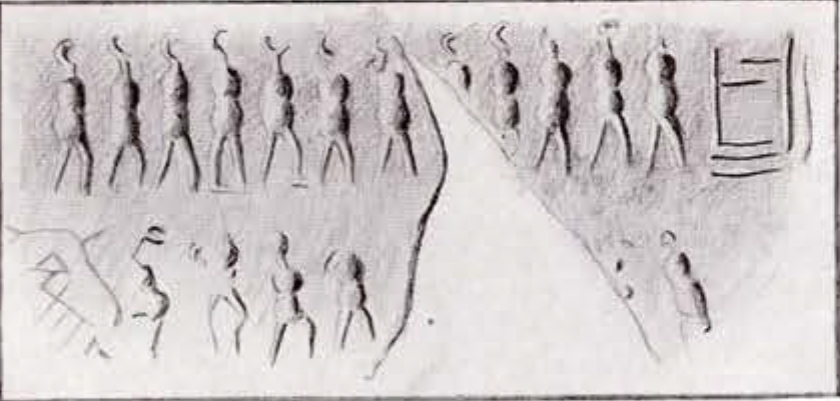
Museum Object Number: B8970
CBS. 8970.
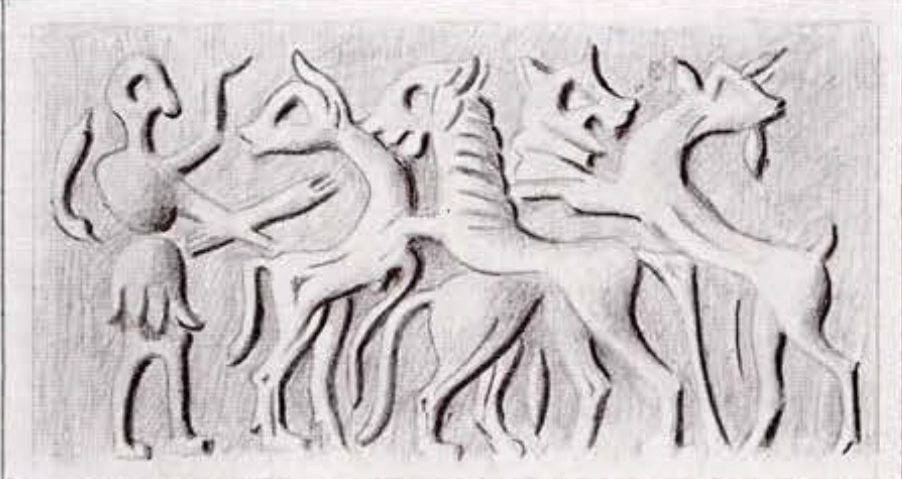
Museum Object Number: B14417
Image Number: 7383
Cylinder seal in calcite stalactite. CBS. 14417.

CBS. 7063.

Museum Object Number: B8182
Image Number: 7378
Impression on a fragment of clay sealing. CBS. 8182.

Museum Object Number: B8204
Image Number: 7379
Impression on a fragment of clay sealing. CBS. 8204.

Museum Object Number: B14242
Impression on a fragment of clay sealing. CBS. 14242.

Museum Object Number: B1113
Image Numbers: 7381, 7382
No. 67. Gilgamesh, Eabani and a Sumerian king in contest with wild beasts. This cylinder has two registers of figures closely and deeply engraved, and some of them very unusual. The upper register has four groups. A nude Gilgamesh in front face with wild locks and beard stands between two lions crossed with two bulls. The same but in profile fights with a rampant bull. A very extraordinary heraldic composition is formed of a lion headed man triumphant over two reversed animals, a lion and a deer. He holds them by the tail, one of which ends in a small lion’s head. The last group shows an archaic human figure, with birdlike head in profile, hair bound by a fillet, or covered with a turban, a short fringed Sumerian skirt, who holds by the hind leg a reversed ibex. The cuneiform character for king: lugal, engraved behind his head, seems to establish his quality. On a marble cylinder seal from Tello,2 the same royal figure with latticed cap, long hair and beard, and a short loin cloth embroidered on one side, is represented fighting a lion. This would explain the presence, in scenes of Contest of Gilgamesh with wild animals, of a purely human figure, with turban, loin cloth or flounced skirt like Ur-Nina, the old Sumerian ruler of Lagash.
The lower register has six groups, two of which show the same extraordinary composition as above. The lion headed man triumphant over two reversed lions holds them by the tail, which this time ends in two ibexes’ heads. In the second group the lion man has a Gilgamesh head, with wild locks and beard, and the two reversed lions seem to melt into Gilgamesh’s body, who holds them by the tail. One of the tails ends in a lion’s head. Between the two groups, the bull man Eabani, spear in hand, seizes a lion by the tail. The three last groups are, a rampant lion crossed with an ibex; Gilgamesh holding a lion by the hind leg; Gilgamesh with head in profile ready to strike an onrushing lion.
Cylinder seal. Lapis lazuli. CBS. 1113.

Image Number: 7405
Impression on a fragment of clay sealing. The large seal was about 30 mm. in diameter. CBS. 7059.

Museum Object Number: B11158
Image Numbers: 7406, 7407, 10071
No. 176. The celestial court and the bird man brought in judgment. The mythological scene in the upper register shows an assembly of enthroned gods surrounded by worshipers or divine attendants. All the gods have the horned crown or mitre and the flounced Sumerian skirt, or a shawl of the same material covering one shoulder. The first group on the left seems to represent a god, with a goddess seated in his lap, like the famous group of Ningirsu and Bau discovered at Tello,3 or the hero Etana carried to heaven by the eagle.4 The second god is probably Shamash with the flaming wings, and the third Ea holding to his breast the spouting vase. A fourth and last god on the extreme left is very indistinct. The divine attendants stand up with clasped hands as becomes servants. They have the horned mitre as a sign of rank, but only a flounced skirt leaving arms and chest bare, stripped for action.
In the lower register a very indistinct seated god—the judge—is approached by a procession of figures including two bird men. The leader seems to carry a short stick in his extended hand and a club on his shoulder, his only garment is the flounced Sumerian skirt. He is a minor servant of the god, an usher, a club bearer.
The two bird men are not, as in most cases, prisoners with hands tied behind their backs, but like the leader seem to carry two weapons, one on each shoulder. The first of these with head turned back is probably introducing the second. The last three figures are dressed and armed like the leader. They carry different objects hanging from crooked sticks over their shoulders, first a net with fruits or some provisions, next a bunch of dates and a small bird, or captured bird man, last a very indistinct figure, but all of which seem to be the symbols of fruitful vegetation, and suggest protection against damages done by the enemy birds. This archaic composition although incomplete and defaced is very rich in details and betrays a vivid imagination.
Impression on a fragment of clay sealing, with marks of string at the back. CBS. 11158.

Museum Object Number: B13870
Image Numbers: 7408, 7409, 10073
Impression on a fragment of clay sealing. CBS. 13870.

Museum Object Number: B5132
Image Number: 7385
No. 142. Two nude hunters in contest with the lion, in Akkadian style. They are divine heroes like Gilgamesh, with horned mitre and their hair tied in a loop behind. One has a beard and a loin cloth, the other is beardless and nude. The lion with sharp gaping jaws, a line of hair under his belly, is characteristic of the Akkadian style about B. C. 2600, as is also the clear composition that avoids the mixing and crossing of rampant animals in honor in Sumerian Lagash about B. c. 3300.
The shape of the horned head dress also varies with the progress of times. It is an accepted emblem of divinity. The bull man Eabani has naturally the round crescent horns of the bison. The Elamite used to picture the bison in human attitude throwing the arrows like a thunder god. The Sumerian gods at the time of Ur-Nina wear a horned crown with feathers and a bull face in relief as a central ornament. Later on the conical cap or mitre is adorned with a simple pair of horns, the points of which meet in front. Under Sargon of Agade, the pairs of horns have been increased from one to four. The horned mitre with the four pairs is henceforth the classical emblem of gods, goddesses and heroes. The long hair common to men and women is bound about the head by a fillet and tied in a loop behind.
The nude primitive hunters, whatever be the length of their hair, are mostly beardless. The full grown beard of a Gilgamesh in front face, while known as early as Ur-Nina, is not the most usual type. Eabani alone has naturally the full beard of the bison, and its wild locks hanging like tresses on his back. The Sumerian god Ningirsu on the stele of the Vultures has only a necklace beard below his chin, with smooth shaven lips and cheeks.
The inscription reads Ninmu son of Balala. Cylinder seal from Hillah. Serpentine. CBS. 5132.
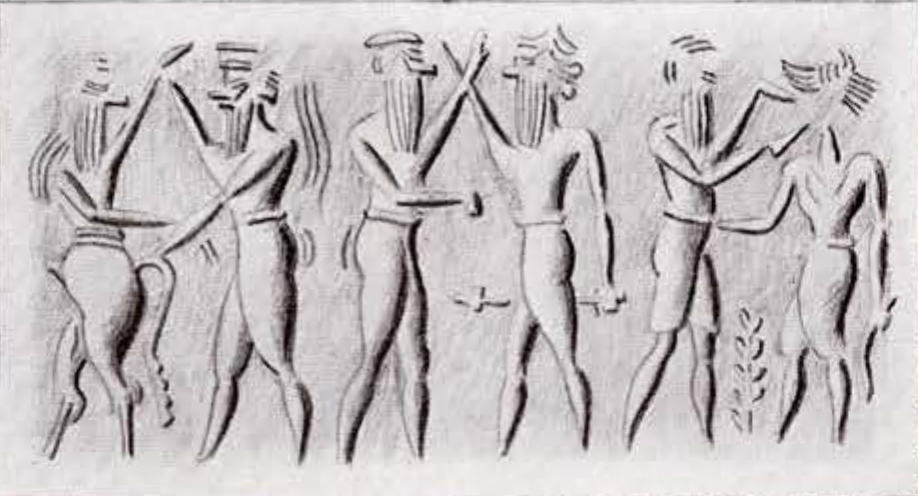
Museum Object Number: B9095
No. 150. Akkadian school. Contests of divine heroes of the cycle of Shamash. Shamash illuminated with rays but stripped like an athlete except for a belt, fights with Eabani. They have locked hands while the god seizes him by the tail. Shamash has a horned mitre, a beard, and his hair tied in a loop behind. Eabani has long flowing hair and a belt.
Two hero fighters dressed like Shamash but without his rays, try to reach each other’s crown. One has a dagger, the other a club.
The last two are human fighters with bare head and short loin cloth. The victor pulls back the head of his enemy in order to cut his throat. The broken club and hanging arms of the latter prove him utterly powerless.
Those nude athletes have like Gilgamesh their loins girded with a belt, the loose end of which hangs on the hip. They have a long beard, their hair tied in a loop behind, and a homed mitre never worn by Gilgamesh. They exemplify the fights of Shamash against clouds and darkness, and his triumph over his enemies. Shamash himself with rays from his shoulders takes part in the battle. Pulling down the enemy’s crown, or stepping on his leg is a natural and clear symbol. The separate grouping of fighters is in the best Akkadian style.
Cylinder seal. Serpentine. CBS. 9095.

Museum Object Number: B8077
Image Number: 7387
No. 152. The triumph of a warrior god and of Ishtar over her enemy. The god steps over a small degree or stage tower suggesting a mountain, like the rising sun god Shamash, but his arms are not the notched sword of Shamash. He has an axe in the left, and in the right the shaft of a colossal caduceus, with a central club and two curved blades ending in lions’ heads on either side. This is the emblem of a warrior god like Ninib, Nergal or Meslamtaè. The god has not a shawl opening in front to allow a free action of the bare leg, but rather a Sumerian skirt closing behind. Chest and arms are bare. He wears the horned mitre, a beard, and his hair tied in a loop behind. The stage tower under his foot is a symbol of his temple and residence.
Ishtar stands in front face with weapons arising from her shoulders. She has a horned mitre, locks on either side, a flounced robe covering both shoulders, in the attitude of the war goddess Innana leading prisoners unto Anubanini king of the Lulubi on the rock relief of the Zagros pass near Seripul. With the help of a divine attendant she seizes her enemy at body and arm. The prisoner has a horned mitre, a beard, his hair tied in a loop, a plaited shawl girded about his middle, and a curved club with projecting blade ending in a lion’s head. He is certainly a war god. And this is perhaps an episode of the triumph of Ishtar over the god of Hades. The divine attendant who arrests the god and pulls down his mitre, wears a flounced shawl opening in front, and a strange head dress apparently with stag horns.
Impression on a fragment of clay sealing. CBS. 8077.
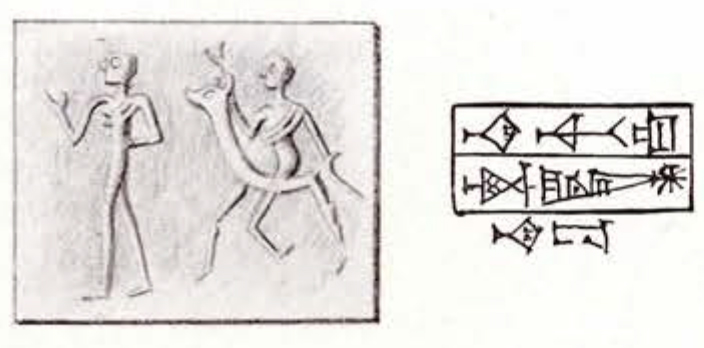
No. 154. The rider astride on horseback? An unusual and remarkable scene in which one would fain recognise the first representation of the horse in Babylonia. But there is some doubt about the identity of the animal, if there is none about the new manner of riding, of that human rider with his whip in hand. The same is probably represented standing, one hand up in sign of adoration. His name adds a new interest to the scene. It reads:
Natium servant of Lugalannatum.
There was a Lugalannatum ruler of Umma in the land of Sumer not long after Eannatum and Enannatum of Lagash. But the actual Lugalannatum, while a Sumerian, must be a more recent person. The name of his servant is the main interesting point. Natium is probably a name of function, which means in Akkadian: the striker, the driver. There is a seal of a certain Bulalatum a daughter of Datinahum, who claimed to be a natit of the serpent goddess Kadi, that is a feminine counterpart of the natium, whatever be her function of priestess or votary of the serpent goddess. The rider of the seal has a birdlike head in profile with no distinct hair or beard, and a strap across his shoulders. His animal may be a horse or a donkey. On the only other known example of the same rider,5 the animal has been called a bull, and the rider identified with the thunder god Ramman Adad. But if we consider that this seal dates probably from the time of the Guti invasion, this manner of riding astride seems a new and foreign feature imported from the northeast by the Guti people. The earlier practice was to drive from a chariot, while a few archaic gods and goddesses stand on the back of winged dragons. This is also the attitude of the storm god standing on the bull, but never riding astride, and of Hittite and Assyrian gods standing on various animals.
Cylinder seal. Black diorite. CBS. 5028.

Museum Object Number: B4079
Fragment of clay relief. CBS. 4079.

Museum Object Number: B1004
Image Number: 7389
No. 216. The worshiping of the spearhead, the emblem of Marduk? The seated god has one hand extended in sign of welcome and perhaps a scepter in the other. He has a horned mitre, a beard, his hair short on the neck, a plaited robe and a cubic seat. The most remarkable thing about him is his emblem, a colossal spearhead on a shaft resting on a large base in front. The spearhead, a well-known symbol of Marduk, is rarely found before the first Babylonian dynasty, and exceptionally on archaic Elamite painted pottery. On the so curious Blau stones, now in the British Museum, a priest or god with a spear in hand is approached by a worshiper in short tunic, his long hair bound by a fillet, his two hands up in sign of adoration. A colossal spearhead or copper lance with the name of an early ruler of Kish and the figure of a rampant lion engraved has been discovered at Tello. It was fixed within a shaft in the very manner represented on the seal, by means of four rivets driven across the shaft and the inner flat copper tang. The Elamite painted pottery has a spear as an emblem of worship raised on a square base. It would be interesting to trace the cult of the spearhead from Babylon through Kish to Elam.
Of the three approaching figures, the first a priest or divine attendant touches with his hand the shaft of the spear. He has a beard, his hair bound by a fillet, and a plaited robe. The worshiper and his servant keep their hands clasped or hanging. They have a beard, a fillet about their short hair, and a tunic reaching below or above the knee, perhaps after the Elamite style.
Cylinder seal. Shell. CBS. 1004.
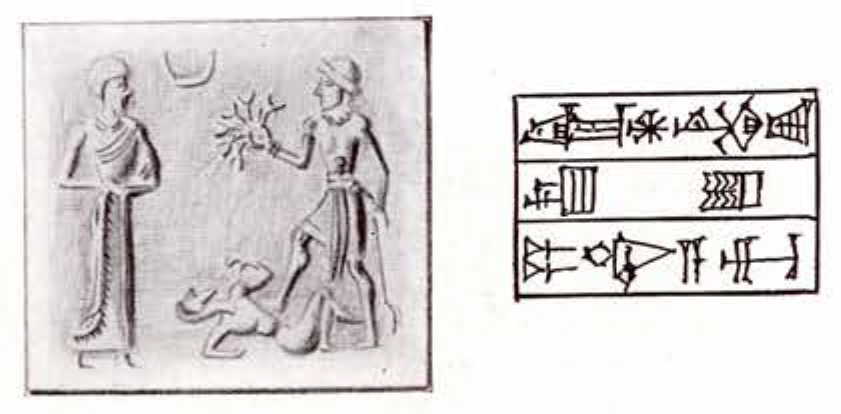
Museum Object Number: B5012
No. 239. The worshiping of the victorious king with a turban. The king treads down his enemy like another war god, but instead of the horned mitre, he wears for the first time the low woollen cap or turban, well known as a headdress of the patesi Gudea about B. c. 2400. The turban is a landmark in history and art. The king is shaven and shorn, or has only short hair under his turban. He wears a loin cloth, or tunic girded about his middle, a necklace, and a dagger stuck in his belt. In his right hand he grasps a sheaf of six weapons with round heads like clubs and in his left a curved scimitar. He steps on a naked enemy lying on his back with hands up in sign of fear and prayer. The worshiper, a shaven and shorn Sumerian, probably the scribe owner of the seal, stands in front of the king with clasped hands as becomes a servant. He wears a necklace, emblem of dignity, and a fringed shawl covers his left shoulder.
The king has the same attitude as many victors represented on steles and rock reliefs of the time of Agade. But Sargon and Naram Sin and their warriors wear helmets adorned with horns in the case of the king, while Anubanini king of Lulubi, and the king of the stele of Sheih-han have only the low woollen turban. This human headdress of the Sumerian Gudea, as well as of the Amorite king Hammurabi, seems to have been introduced in Babylonia at the time of the Guti. The mountaineer prisoners of king Anu-banini wear the woollen turban.
Most remarkably the woollen turban seems to replace the horned mitre on the head of many gods at the very moment when the kings of Agade and Ur began to be worshiped as gods. The earlier kings were bareheaded, or had a fillet about their head, or wore a flat cap. Naram Sin, who was called the god of Agade, assumes the divine horns on his stele of victory. The kings of the third Ur dynasty built temples to their own deity, and are represented enthroned but wearing only the woollen turban. That habit prevailed, and so did after them Sin the Moon god of Ur, and Martu the national god of the Amorites, wear a turban instead of the traditional horns.
It is very likely that the turban is a human head dress of foreign origin, adopted by all in Babylonia after the Guti invasion, worn by Babylonian kings worshiped as gods, and by some foreign gods, while the homed mitre was retained as emblem of minor deities, or on the heads of gods not so close to the ruler and his capital.
The king of the present seal has the attitude of Nergal, the Sumerian war god, or of the Amorite Adad. His next of kin would be the king represented on the rocks of Sheih-han with a turban, no beard, a tight tunic and a hatchet stuck in his belt. Among the few seals with a similar figure, one is inscribed to the name of Hanilû. There was a god Han and a country of Hani under Hittite influence between Antioch and Karkemish.
All indications point toward the representation of a war god, under growing western influence at the time of the third Ur dynasty.
The seal is inscribed to Kad Nannarzu, scribe, son of Lulamu.
Serpentine. CBS. 5012.

Museum Object Number: B5021
No. 240. The ashhera or clubs emblems. The scene represents the worshiping of a seated god with horned mitre, flounced robe, beard and hair tied in a loop behind. The most interesting feature are his emblems, two colossal clubs with five heads, placed on either side of the throne, and further two serpents whose tails seem to unite to form a thunderbolt over an indistinct crouched animal. The attendant goddess with the same mitre, hair and flounced robe, leads by the hand the shaven and shorn worshiper in a fringed shawl. Both adore with one hand up. There is a crescent above and a sun disk within.
A fragment of one of the seven steles of Gudea, erected in the temple of Ningirsu of Lagash, has a picture of a square base with a line of weapons and emblems on either side of a central stele. The first weapon is the very club with five heads of the present seal. The second is a club with round head, the third a shaft with curved blade ending in a lion’s head. The place of worship on the earliest Sumerian relief is a weapon, a raised stone, stele or statue, between two colossal clubs, poles or ashheras. On the curious seal of a doctor, Ur lugal edinna, discovered at Tello, the emblem between the two clubs is no other than a colossal whip with double thongs, the top of the handle being adorned with a deer’s head, and the inscription is an invocation to the god Edin mugi the shepherd of the divine does or female lulimu.
Door posts used to mark the threshold of the shrine, the entrance of the sacred area. Bronze figures of a kneeling god driving a sacred peg were buried in small brick vaults on either side of the gates.
Each god had his special emblem. The emblem of Nergal is a club or scimitar with curved blade ending in a lion’s head. But he had many other weapons. There are lists of more than twenty weapons of the god Ninib, like net, sword, dagger, bow, lasso, shield, clubs with a stone head, or with five, seven, or fifty heads. Ningirsu of Lagash, another Ninib, inhabited the temple of “the fifty.” He is represented on a seal impression of the time of Gimil Sin of Ur, with a rampant lion behind his throne holding up the club with five heads like the one of this seal, while another seated lion supports the throne. The flying eagle of Lagash is displayed above. The club with five heads may be an emblem of any war god like Nergal, Ninib, or Ningirsu.
The club with seven heads belongs to the same mythological cycle.
A clay model from Nippur in the Museum shows the god Enlil with club and sword standing in his shrine. Two rude colossal clubs are moulded on the outside, on either side of the door.
The lightning fork on a bull is the usual symbol of the storm god. But the two serpents of the present emblem have a closer resemblance to the caduceus of Ishtar the war goddess. She is perhaps the attendant goddess who leads the worshiper, the feminine counterpart of the god, whatever be her name, Ninlil, Ishtar, or Ninkarrag, another name of Gula the wife of Ninib. Ninlil is early represented as a nude figure standing thunderbolt in hand on a winged dragon vomiting venom. The emblems of the wives of Nergal and of Adad are not known.
Cylinder seal. Serpentine. CBS. 5021.

Museum Object Number: B5032
No. 241. War and hunting gods. The crooked stick of Martu. The emblems are the most interesting part of this seal, outside of the two nude hunters with head in profile, short hair, a beard, a belt, and one at least a loin cloth, who lift two lions by legs and tail while stepping on their heads. The emblems are the weapon with curved blade ending in a lion’s head, and a seated dog with a crooked stick on his head.
The two hunters belong to the good Akkadian period, while the curved weapon, the crooked stick and the seated dog are characteristics of the new period that followed the invasion of the Guti, and the rising in power of the Amorite race. Symbolism and syncretism replace more and more the fresh imagination that had created the first mythological scenes. Various emblems fill the free ground of the field and serve to identify a common figure of a seated or standing god, or suggest minor deities next to the leading god. They are an image of the composite pantheon of a mixed population.
The rich collection of symbols on boundary stones about B.C. 1300 to 800, gives us representations of the gods, with their features, weapons, shrines, symbolical animals and even names written to avoid any mistakes. The curved blade ending in a lion’s head is a symbol of Nergal of Kutha, god of war, of death and pestilence, a king of Hades. His animal is the lion, a lion’s head, often schematic and mistaken for an asp or serpent’s head, adorns his weapon, with tufts of hair or a mane along the shaft, which may develop into dragon’s wings.
The meaning of the seated dog and of the crooked stick, next to the emblem of Nergal and belonging to the same mythological cycle, is not so easy to determine. The dog is the emblem of the goddess Gula wife of Ninib, a warrior god or quradu like Nergal and Shamash. A weapon is their usual emblem, weapon with lion’s head of Nergal, with vulture’s head of Zamama, another war god, with square head of Shugamuna the Cassite war god. Ninib’s weapon is a round club between two curved blades. The rising sun god Shamash carried a notched sword, Marduk a scimitar, while his emblem is the spearhead, and Ishtar a scimitar and caduceus. The Syrian Ishtar is represented by a scorpion. The dog of Gula, while closely associated with those war emblems, is not found on Cassite monuments with the crooked stick on his head.
The crooked stick seems to belong to the Martu or Amorite period to which the Cassite invasion put an end, about B. c. 1700. It is the proper symbol of Martu the god of the Amorites. Its use and origin is still a problem. The old Sumerian rulers of the time of Ur-Nina used a shorter stick with a double curve and formed of several splints bound together by knots of leather or copper. The Martu stick has a long, straight and simple staff, on which the crooked piece, in many instances with a cloven end, seems to be fixed by a rivet. It is carried with the curve on high like a shepherd’s crook, and such was probably its first use. It is not a throw stick or lagobolon for which use its long handle would make it unfit. It was kept in hand, but its curved, hardened and perhaps sharpened head would serve for cutting and catching.
Martu the Amorite was a hunter and a warrior. Hunting is just war against animals, and the same weapons are used in both cases. The war gods were first hunter gods. The crooked stick must have been the weapon of Martu in the original home of the Amorites. He is usually represented crooked stick in hand, his foot lifted on a deer or antelope, his head covered with a high foreign mitre and certified by an inscription as the Anu the supreme god of the Amorites. More frequently he has adopted the turban familiar in Babylonia since Gudea. He does not wear the long robe or shawl falling to the ankles, but a loin cloth, or a short tunic with a belt, and a shawl thrown over the left shoulder and reaching in front to the knees. One arm is bare and hanging, the other hand presses to his breast a short club, at times together with a crooked stick or scimitar. His hair is short, his beard large and curled. He is a Semite akin to the earlier Akkadians. His fortune was bound with that of the Amorite race. When imported into Babylonia, he adopted the land and manners, copied several indigenous gods or was identified with them. He was a new Enlil. At Babylon he was Marduk and his crooked stick developed into a scimitar. His garment grew to a long embroidered robe. His hair was tied in a loop after the old fashion. He left the turban for a high tiara adorned with embroideries and feathers. His animal was the wingless dragon. In his left hand he carried the ring and scepter of Shamash.
In Kutha, he was a war and hunting god like Nergal and Ninib. He belonged naturally to their cycle. The seated dog with the crooked stick is frequently associated with Nergal’s weapon. On a limestone seal discovered at Susa in the foundations of the temple of Shushinak a deity holds the crooked stick over the head of the seated dog and wears a high foreign mitre with feathers and horns. Curiously enough the seal belongs to a servant of Gula.
The dog being the well known emblem of Gula, why should not the crooked stick be an emblem of Ninib or Martu, the hunter gods, a token of victory and happy hunting? On Cassite boundary stones several figures of a dog trying to catch a flying bird, or of a fox or shakal below a crooked stick, may be interpreted in the same manner.
A last emblem between the two groups, the so called libra or measuring rod, is another sign of the time never found before the period of Agade.
Cylinder seal. Jadelike stone. CBS. 5032.

Museum Object Number: B5019
No. 323. Martu and Aba his wife? The name of Martu’s wife was not known before. Aba has been considered so far as a Cassite deity. The bearded god is seated holding a small cup below the crescent and the sun disk with cross and rays. He has a turban, a fringed shawl, a seat covered with flounced material and resting on a brick dais, characteristic of the period of the third Ur dynasty. In front of him there is a crooked stick, and behind a passing dog, very proper emblems of Martu and his wife identified with Ninib and Gula. Shepherd’s crook and dog would be the fit symbols of the gods of the wandering Amorites.
The worshiper with short hair, and beard and a fringed shawl stands with clasped hands. The attendant goddess—Aba—worships with both hands up. She is dressed with horned mitre, hair tied in a loop, and a flounced robe after the Babylonian style. Between them there is a squat monkey and a small bandy legged figure, with turban and short loin cloth, adoring with one hand up.
Cylinder seal. Hematite. CBS. 5019.
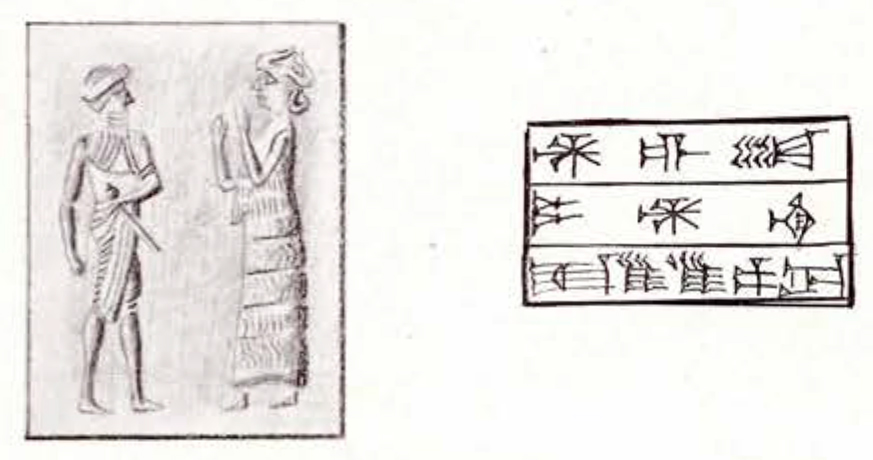
Museum Object Number: B3797
dumu Anna
sabar him-turn sig-gìn
son of Anu,
who stirs up mighty dust clouds.
Cylinder seal. Serpentine. CBS. 3797.

Museum Object Number: B1050
Cylinder seal. Basalt. CBS. 1050.

Museum Object Number: B1078
Image Number: 7395
Cylinder seal. Hematite. CBS. 1078.

Museum Object Number: B1097
Cylinder seal. Hematite. CBS. 1097.
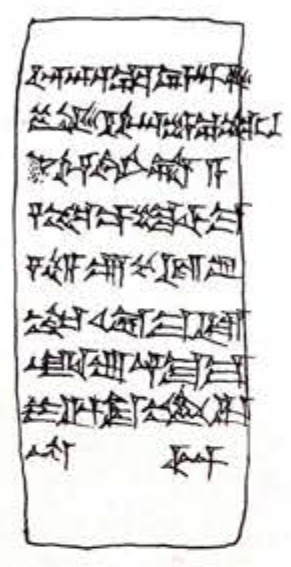
Museum Object Numbe: B5559
thy brothers, of the gracious goddesses
of the gates, the sorceresses;
all that they wish,
all that they find suitable,
great or little,
may they send it and
may it go its way.
Stone of incantation.
Nippur. CBS. 5559.

Museum Object Number: B9401
Image Numbers: 7396, 7397, 7398
The reverse has a puzzling inscription perhaps in early Greek or Carian characters:
i a e u
e g sh n
z m
Bought by Dr. Peters in North Syria, in 1891. CBS. 9401.
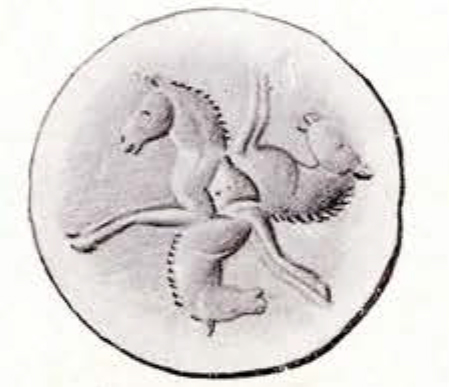
Impression on a clay tablet of Nippur. CBS. 12841.

Impression on a clay tablet from Nippur of the stone seal of Itti-Bêl-abnu, high officer, of Artahsar. CBS. 5379—BE. IX, No. 4.

Impression of the stone seal of Ellil-mukîn-aplu, governor of Nippur, son of Kasir. Nippur tablet. CBS. 5208—BE. X, No. 88.

Impression of the stone seal of Shamash-barakku commander of the Urashtan and of the Miliduan—legions?—son of Nidintum-Bêl. Nippur tablet. CBS. 5230—PBS. II, 1, No. 95.
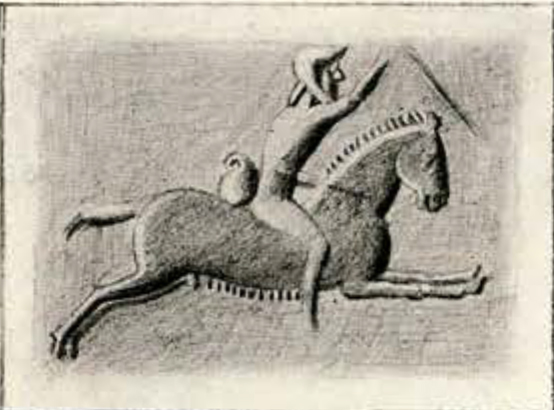
Impression of the stone seal of Bêl-danu, son of Bêl-bullitsu. Nippur tablet. CBS. 6125—PBS. II, 1, No. 107.

Impression on a clay tablet of Nippur. CBS. 5365—BE. X, No. 22.

Impression of the iron ring of Hannâ, chief keeper of the royal poultry, son of Minâhhimmu. Nippur tablet. CBS. 12853-PBS. II, 1, No. 133.

Impression of the stone seal of Ellil-mukîn-aplu son of Nasir. Nippur tablet. CBS. 12870—PBS. II, 1, No. 144.
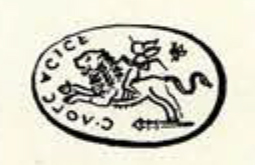
Museum Object Number: B14531
Image Numbers: 6356, 7399
A winged Eros rides, whip in hand, on the back of a galloping lion, which he leads with the left hand. The hind legs of the lion are treading on a three headed club like a burning torch. A bee or butterfly is hovering above or hurrying in hot pursuit. A real poem of love, and a marvel of engraving.
Maxwell Sommerville Collection. CBS. 14531.
1 H. WARD, Seal Cyl. No. 449, 390.↪
2 Déc. pl. 30, fig. 5 a—b. Cp. the seal of a king of Uruk, in the Metropolitan Museum, WARD Cyl. Seals No. 29.↪
3 Déc. pl. 25, fig. 5.↪
4 One shell seal with the figure of Etana comes from Tello, Déc. pl. 31bls, fig. 13. A second example belongs to the Berlin Museum, Sp. 234.↪
5 DE CLERCQ, Cal. No. 181b1s. H. WARD, Seal Cyl. No. 137b.↪

